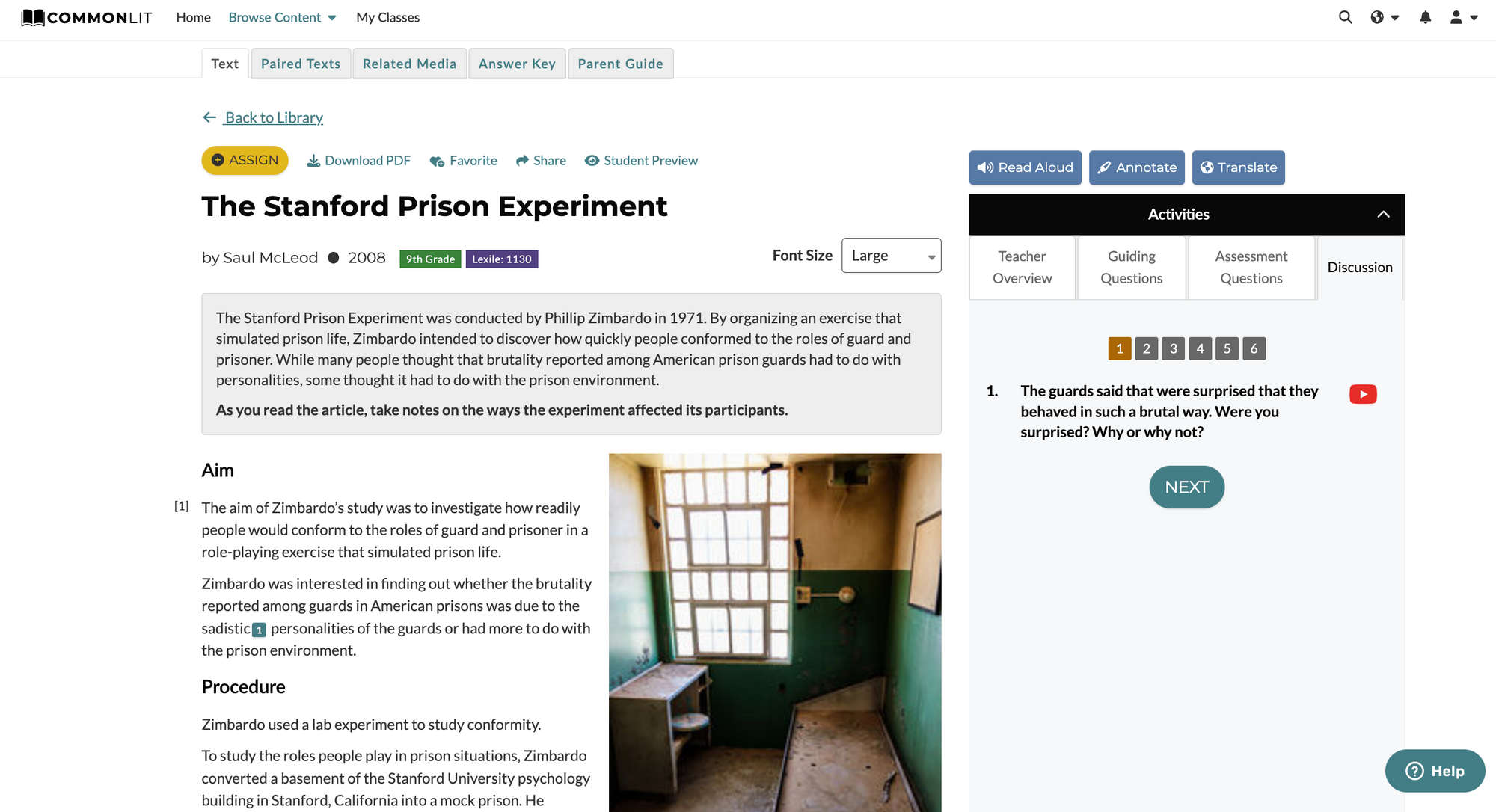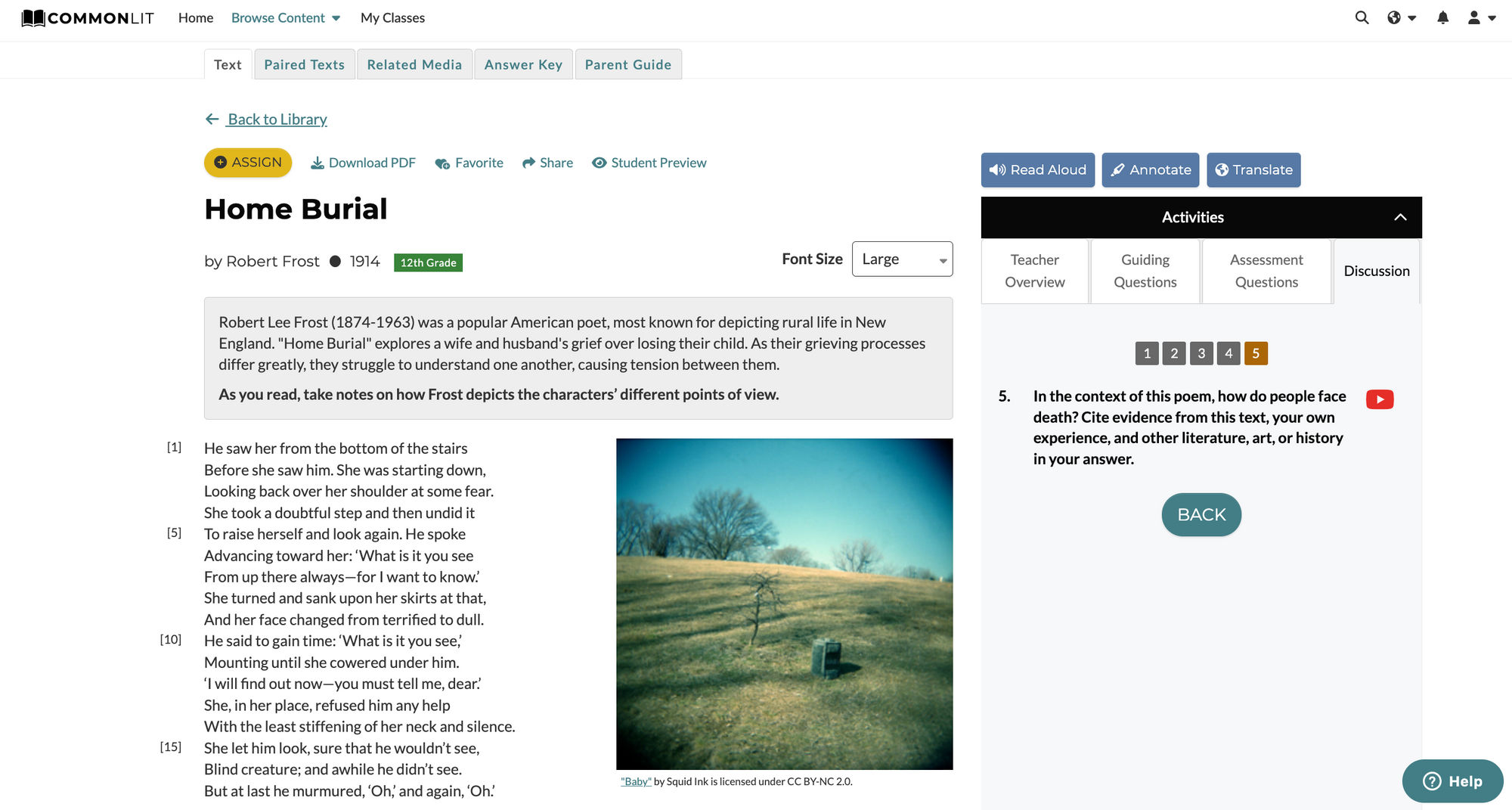Analyze human psychology and literary themes in Lord of the Flies by William Golding with these supplemental readings.
CommonLit’s digital literacy program provides Book Pairing resources for over a hundred novels. These paired texts provide essential background information and literary connections to help students deepen their reading comprehension and engage fully with every book. Our Book Pairings include information about the supplemental texts, guidance on when to introduce them, and discussion questions to help students make cross-textual connections. Bolster your reading curriculum while teaching essential skills in preparation for any reading assessment by planning your novel study unit with our Book Pairings.
Lord of the Flies by William Golding follows a group of boys stranded on a deserted island as they attempt to survive in the wild. The novel follows the boys’ relationships with each other and their attempts to organize a society. Ultimately, the characters reveal how human nature, without structured society, can drive individuals to violent and even extreme measures.
Exploring the Good and Evil in Human Nature
The following informational texts examine the origins of good and evil in human behavior. Read these texts to create essential connections to the characters’ actions in the novel and deepen reading comprehension.
“What Makes Good People Do Bad Things?” by Melissa Dittmann (11th grade)
In this article from the Monitor on Psychology, researcher Melissa Dittmann describes her findings on what drives people to commit immoral acts.
Assign this text to students before they begin reading Lord of the Flies to provide them with theoretical background for studying and analyzing the novel’s characters. As students read the book, ask them to consider Zimbardo’s findings about social situations and human nature outlined in this study. Prompt students to take notes on how the social situations in Lord of the Flies shape the morality of the boys’ actions.
“Bullying in Early Adolescence” by Dorothy L. Espelage (11th grade)
This research article explores the roles that peers play in enabling and promoting bullying during early adolescence. This is a great piece for encouraging students to make text-to-self connections along with cross-textual analysis.
Introduce this article after reading Chapter 4, when Jack mocks and attacks Piggy, to explore the nature of bullying among adolescents. Have students use Espelage’s article to discuss whether they consider Piggy to be a victim of bullying. Then ask students, “How do the other boys react to Jack’s treatment of Piggy? Why is Piggy targeted?”
“The Stanford Prison Experiment” by Saul McLeod (9th grade)
The Stanford Prison Experiment was a study that simulated the social dynamics of life in prison. The study was intended to discover how quickly people conformed to the roles of “guard” and “prisoner.” While many believed that brutality reported among prison guards had to do with guards’ personalities, some thought it actually developed based on the prison environment. This text will provide rigorous practice for students to deepen their reading comprehension of psychological and research-based articles.
Assign this study after students finish Chapter 11, when Ralph and Jack struggle for leadership. Use this text to examine social roles in the novel with the concepts of “leaders” and “followers.” Ask students, “How is Jack’s treatment of other boys when he becomes the leader similar to how the guards treat and view prisoners in the experiment?”

Literary Connections to Themes in Lord of the Flies
Lord of the Flies tackles themes of grief, loss, and evil. Create a multi-genre analysis by supplementing your novel study with relevant poems and allegorical stories.
“The Man in the Well” by Ira Sher (9th grade)
In this allegorical story, a group of children abandon a man to die in a well. This fictional text is a poignant portrayal of the cruelty of children and aligns well with the informational texts about good and evil in human nature.
Have students read this allegory after finishing Chapter 7, when Robert is treated like a pig by the other boys, to explore what motivates people to be cruel. Why are the boys in Lord of the Flies motivated to prod and stab Robert like a pig, causing him pain? How do the childrens’ ruthless treatment of others make them feel in Lord of the Flies and “The Man in the Well.”
“The Lottery” by Shirley Jackson (9th grade)
This classic story by Shirley Jackson describes an entire town as they participate in a ritual that turns surprisingly sinister. The short story includes plenty of foreshadowing and irony, making it a great supplemental text to teach authors’ craft.
Have students read this allegorical story after reading Chapter 9, to compare the murder of Mrs. Hutchinson with the murder of Simon. Ask students to discuss what drives the townspeople and boys in Lord of the Flies to kill someone else. How do the boys behave as they attack Simon? How does this compare to the townspeople’s approach to Mrs. Hutchinson’s inevitable death?
“Home Burial” by Robert Frost (12th grade)
This poem follows a husband and wife as they process the loss of their child. The two struggle to understand each other due to their unique grieving experiences, causing further tension and frustration.
Have students read this poem after finishing Lord of the Flies. Then, ask them to compare the different ways that the parents in “Home Burial” and the boys in the book deal with death. How does death cause a strain on the relationships in both texts? How do the boys react when they must admit the deaths to an adult at the end of the book?

Nonfiction Texts About Group Psychology
William Golding explores the impact of group psychology throughout Lord of the Flies. These nonfiction texts provide context and extension to help students understand the boys’ behavior in the group.
“The Madness of Humanity Part 3: Tribalism” by Marcelo Gleiser for NPR (10th grade)
In this article, Marcelo Gleiser discusses what role tribalism plays in our society today and the scenarios it can cause. Tribalism, as described in this text, creates the sense of loyalty and belonging that members feel for their group.
Assign this text after students read Chapter 8, when Jack forms his own tribe, to provide them with information on tribalism and group behavior. Ask students to assess how Gleiser describes the importance of belonging to a tribe, and how the sense of belonging can affect an individual. How does belonging to Jack’s tribe drive the other boys to extreme behavior, similar to the behavior explored in the article?
“The 1972 Andes Flight Disaster” by CommonLit Staff (8th grade)
This nonfiction text details the experiences of aUruguayan rugby team that crashed in the remote Andes mountains in 1972. The young men resorted to dire measures to survive in the Andes. Note: “The 1972 Andes Flight Disaster” includes depictions of cannibalism that students may find disturbing.
Have students read this informational text after finishing Lord of the Flies, to provide another example of a group of people stranded in the wild. How do the obstacles the men in “The 1972 Andes Flight Disaster” faced compare to the obstacles the boys faced in the novel?
Next Steps
Looking to teach another novel? Check out more of our Book Pairings for additional stories, poems and informational texts to supplement your ELA curriculum.
If you’re interested in learning all about CommonLit’s free digital literacy program, or our comprehensive 360 Curriculum, join one of our upcoming webinars!


